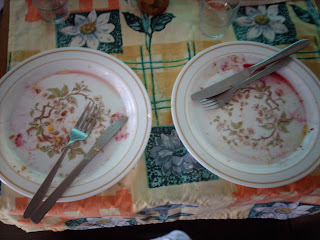
Lunchtime was looming. Didn't feel like cooking, so: soup. I don't really make a good soup as yet, although am improving. I know I am improving because Hubs asks for a second bowl. If it's not so good he doesn't. Of course he will always say that it is nice anyway, but one bowl: soup not really that good. Two bowls, and it's great!
Have tried following a recipe for tomato soup before, and it turned out feeling slimy on the tongue so I couldn't eat it. That was cream of tomato, made with proper cream as well, so was a bit of a waste. Down the sink it went. That was when I was living in the UK. At least here everything goes out onto the compost heap where all manner of wildlife partake of the food which is put there.
I couldn't be bothered to search out a recipe, and here is what I did:
Took all the remaining tomatoes (probably about 2lb) and skinned them. Into pot they went, together with a chopped onion, 1 herb stock cube, salt to taste, good teaspoon of brown sugar because Val up in the Charente said that salt and sugar help keep the colour of tomatoes, but it doesn't matter if they don't because I like the way salt and sugar combine to give food a sweet and sour taste.
It was on my mind to grate a couple of garlic pods (is that what you call a piece of garlic?) but couldn't be bothered.
To stop the tomatoes from burning, I added about quarter of a pint of water: not much, just to moisten the surface of the pan.
Onto the stove, up to boil, then simmered for about 30 minutes or so, just enough time for me to go and harvest some amaranth seed from the veg plot.
Off heat for a moment while I scrabbled about in the underseat storage area of the caravan for my blender, then tomatoes into blender, lid on (?), and toms juiced. It didn't take a huge amount of time to clean up the tomato splash, and perhaps my eagerness to get on with the day was my undoing because I was not alert enough to the position of the lid. Not to worry, everything is a learning curve in life, and next time I will know to make sure the lid is on properly. I did make quite a mess because red liquid spurted up and went everywhere, including over me.
But the good news is, that there was still enough left in the blender to carry on with the soup making, although I had to add a bit more water to bulk up the quantity of liquid.

I was actually getting quite messy by now, what with the blender lid incident, and the mashing of the soup through the sieve. Not to worry though, I remind myself that this is a caravan I am cooking in, so I forgive myself and carry on boldly.
Ooohhh. And now into the fridge for the Creme Fraiche. On yummy yums!
 Now to test that the pot is still fresh, I do feel that I ought to have a taste. Or two. And what about the cream still left on the lid? Mustn't waste that!
Now to test that the pot is still fresh, I do feel that I ought to have a taste. Or two. And what about the cream still left on the lid? Mustn't waste that! Just to prove that it was only a little bit of creme fraiche I tasted!
Just to prove that it was only a little bit of creme fraiche I tasted!Back to the soup: brought pan back to heat, added good 2 - 3 tablespoons of creme fraiche. Kept stirring while soup heated back up. Opened a tin of what I thought was haricot beans, but it turned out to be sweetcorn. Not to worry though: put them into the soup anyway!
Et voila! The proof was in the eating: Hubs not only came back for a second helping, but emptied the pot!

PS. A piece of garlic is called a 'clove'. It came into my mind a minute ago!























